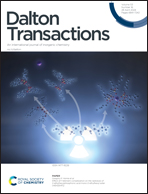Effect of f-element complexation on the radiolysis of 2-ethylhexylphosphonic acid mono-2-ethylhexyl ester (HEH[EHP])†
Abstract
A systematic study of the impact on the chemical reactivity of the oxidising n-dodecane radical cation (RH˙+) with f-element complexed 2-ethylhexylphosphonic acid mono-2-ethylhexyl ester (HEH[EHP]) has been undertaken utilizing time-resolved electron pulse radiolysis/transient absorption spectroscopy and high-level quantum mechanical calculations. Lanthanide ion complexed species, [Ln((HEH[EHP])2)3], exhibited vastly increased reactivity (over 10× faster) in comparison to the non-complexed ligand in n-dodecane solvent, whose rate coefficient was k = (4.66 ± 0.22) × 109 M−1 s−1. Similar reactivity enhancement was also observed for the corresponding americium ion complex, k = (5.58 ± 0.30) × 1010 M−1 s−1. The vastly increased reactivity of these f-element complexes was not due to simple increased diffusion-control of these reactions; rather, enhanced hole transfer mechanisms for the complexes were calculated to become energetically more favourable. Interestingly, the observed reactivity trend with lanthanide ion size was not linear; instead, the rate coefficients showed an initial increase (Lu to Yb) followed by a decrease (Tm to Ho), followed by another increase (Dy to La). This behaviour was excellently predicted by the calculated reaction volumes of these complexes. Complementary cobalt-60 gamma irradiations for select lanthanide complexes demonstrated that the measured kinetic differences translated to increased ligand degradation at steady-state timescales, affording ∼38% increase in ligand loss of a 1 : 1 [La((HEH[EHP])2)3] : HEH[EHP] ratio system.
![Graphical abstract: Effect of f-element complexation on the radiolysis of 2-ethylhexylphosphonic acid mono-2-ethylhexyl ester (HEH[EHP])](/en/Image/Get?imageInfo.ImageType=GA&imageInfo.ImageIdentifier.ManuscriptID=D4DT00424H&imageInfo.ImageIdentifier.Year=2024)
- This article is part of the themed collection: Articles behind our 2024 journal covers


 Please wait while we load your content...
Please wait while we load your content...
